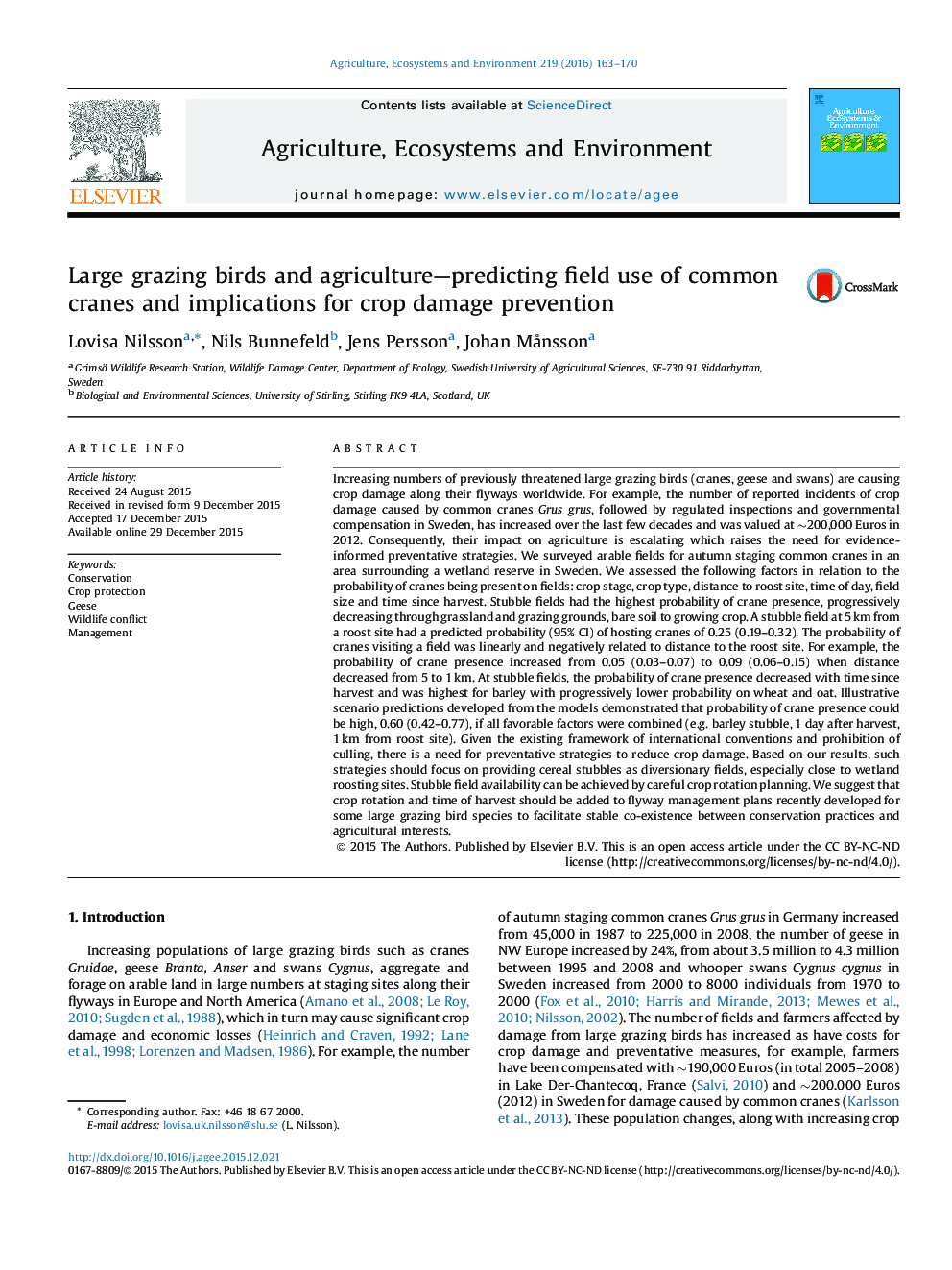| کد مقاله | کد نشریه | سال انتشار | مقاله انگلیسی | نسخه تمام متن |
|---|---|---|---|---|
| 8487529 | 1552033 | 2016 | 8 صفحه PDF | دانلود رایگان |
عنوان انگلیسی مقاله ISI
Large grazing birds and agriculture-predicting field use of common cranes and implications for crop damage prevention
ترجمه فارسی عنوان
استفاده از پرندگان بزرگ و زمینه پیش بینی کشاورزی، از جرثقیل های معمولی و پیامدهای پیشگیری از آسیب زراعی
دانلود مقاله + سفارش ترجمه
دانلود مقاله ISI انگلیسی
رایگان برای ایرانیان
کلمات کلیدی
حفاظت، حفاظت از محصول، غازها، مناقشات حیات وحش، مدیریت،
موضوعات مرتبط
علوم زیستی و بیوفناوری
علوم کشاورزی و بیولوژیک
علوم زراعت و اصلاح نباتات
چکیده انگلیسی
Increasing numbers of previously threatened large grazing birds (cranes, geese and swans) are causing crop damage along their flyways worldwide. For example, the number of reported incidents of crop damage caused by common cranes Grus grus, followed by regulated inspections and governmental compensation in Sweden, has increased over the last few decades and was valued at â¼200,000 Euros in 2012. Consequently, their impact on agriculture is escalating which raises the need for evidence-informed preventative strategies. We surveyed arable fields for autumn staging common cranes in an area surrounding a wetland reserve in Sweden. We assessed the following factors in relation to the probability of cranes being present on fields: crop stage, crop type, distance to roost site, time of day, field size and time since harvest. Stubble fields had the highest probability of crane presence, progressively decreasing through grassland and grazing grounds, bare soil to growing crop. A stubble field at 5Â km from a roost site had a predicted probability (95% CI) of hosting cranes of 0.25 (0.19-0.32). The probability of cranes visiting a field was linearly and negatively related to distance to the roost site. For example, the probability of crane presence increased from 0.05 (0.03-0.07) to 0.09 (0.06-0.15) when distance decreased from 5 to 1Â km. At stubble fields, the probability of crane presence decreased with time since harvest and was highest for barley with progressively lower probability on wheat and oat. Illustrative scenario predictions developed from the models demonstrated that probability of crane presence could be high, 0.60 (0.42-0.77), if all favorable factors were combined (e.g. barley stubble, 1 day after harvest, 1Â km from roost site). Given the existing framework of international conventions and prohibition of culling, there is a need for preventative strategies to reduce crop damage. Based on our results, such strategies should focus on providing cereal stubbles as diversionary fields, especially close to wetland roosting sites. Stubble field availability can be achieved by careful crop rotation planning. We suggest that crop rotation and time of harvest should be added to flyway management plans recently developed for some large grazing bird species to facilitate stable co-existence between conservation practices and agricultural interests.
ناشر
Database: Elsevier - ScienceDirect (ساینس دایرکت)
Journal: Agriculture, Ecosystems & Environment - Volume 219, 1 March 2016, Pages 163-170
Journal: Agriculture, Ecosystems & Environment - Volume 219, 1 March 2016, Pages 163-170
نویسندگان
Lovisa Nilsson, Nils Bunnefeld, Jens Persson, Johan MÃ¥nsson,
